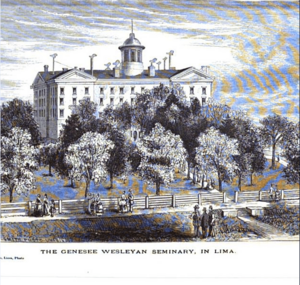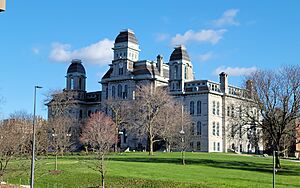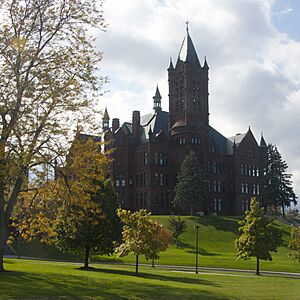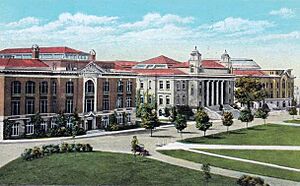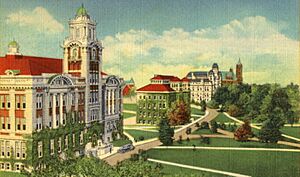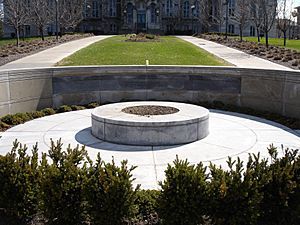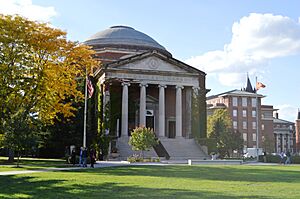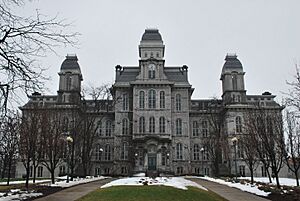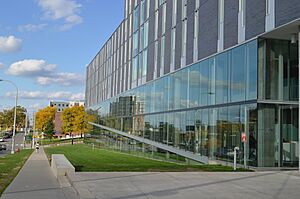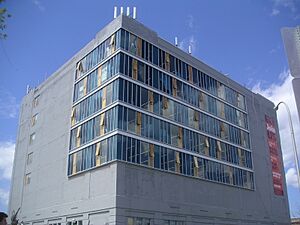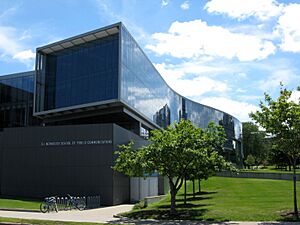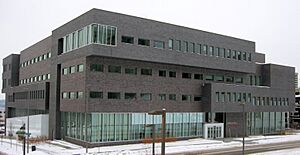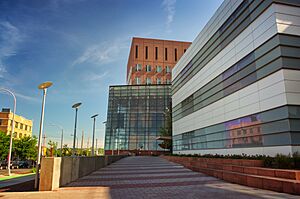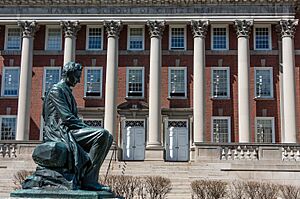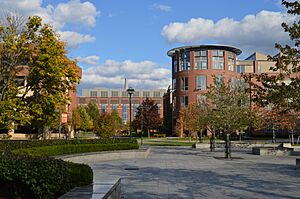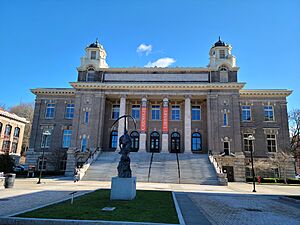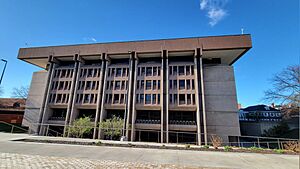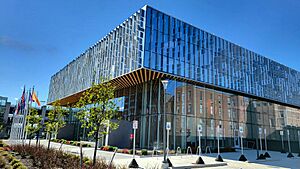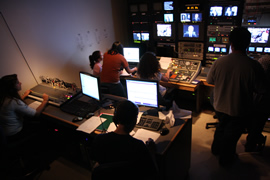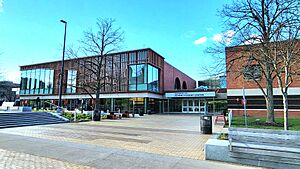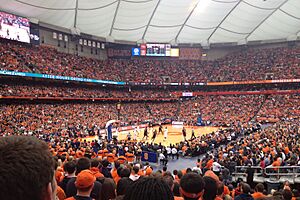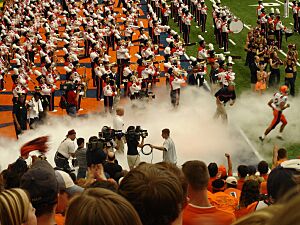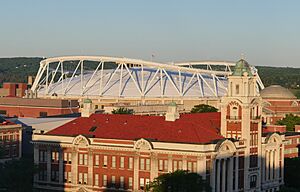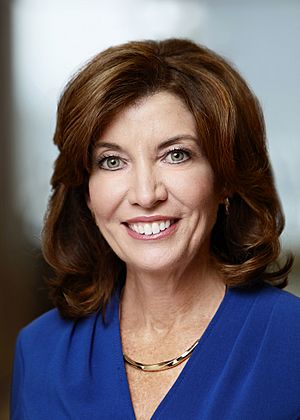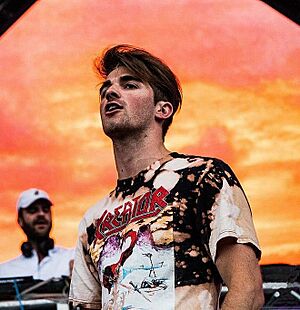Syracuse University facts for kids
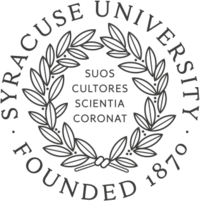 |
|
| Motto | Suos Cultores Scientia Coronat (Latin) |
|---|---|
|
Motto in English
|
"Knowledge crowns those who seek her" |
| Type | Private research university |
| Established | March 24, 1870 |
| Accreditation | MSCHE |
|
Religious affiliation
|
Nonsectarian; historically affiliated with the United Methodist Church |
|
Academic affiliations
|
|
| Endowment | $2.1 billion (2025) |
| Budget | $1.76 billion (2023) |
| Chancellor | Kent Syverud |
| Provost | Lois Agnew (interim) |
|
Academic staff
|
1,848 |
|
Administrative staff
|
3,848 |
| Students | 22,698 (2022) |
| Undergraduates | 15,421 (2022) |
| Postgraduates | 6,552 (2022) |
| Location |
,
New York
,
United States
43°02′15″N 76°08′02″W / 43.0376°N 76.1340°W |
| Campus | Midsize city, 683 acres (276.4 ha) |
| Newspaper | The Daily Orange |
| Colors | Orange |
| Nickname | Orange |
|
Sporting affiliations
|
|
| Mascot | Otto the Orange |
Syracuse University (often called 'Cuse or SU) is a private research university in Syracuse, New York, United States. It started in 1870. The university was once connected to the Methodist Episcopal Church, but it has been open to all faiths since 1920. Its large campus is on University Hill and has many different kinds of buildings. Syracuse University has 13 schools and colleges. It is known for its high level of research.
Syracuse University's sports teams are called the Orange. They play in 20 different sports. SU is part of the Atlantic Coast Conference (ACC) for most of its NCAA Division I sports. Many famous people have attended Syracuse University. These include former President Joe Biden, Nobel Prize winners, Olympic medalists, and Pulitzer Prize winners.
Contents
University History
How Syracuse University Started
Syracuse University's story began with the Genesee Wesleyan Seminary. This school was founded in 1831 in Lima, New York. In 1850, it grew into Genesee College. However, many people thought Lima was not a good location for a college. The college's leaders decided to look for a new home.
At the same time, the city of Syracuse wanted a university. Syracuse had tried to get Cornell University to build there, but it ended up in Ithaca instead. After some disagreements, Genesee College got approval to move to Syracuse in 1869. But a court stopped the move.
So, a brand new university was started on March 24, 1870. This new school was Syracuse University. The Methodist church gave a lot of money to help start it. The City of Syracuse also offered money. Jesse T. Peck, a Methodist bishop, gave $25,000 and became the first president of the university's board.
The university opened in September 1871 in rented rooms downtown. A trustee, Judge George F. Comstock, gave the school 50 acres of land on a hillside. He wanted the university and the area around it to grow together.
Syracuse University was founded to be open to everyone. This meant "open to men and women, white and black." President Peck said there would be "no unfair treatment here against woman." Syracuse had many women students for its time. Men and women studied together in the same classes. They also joined many of the same clubs.
Growing the University Campus
Syracuse University was one of the first colleges to welcome women. In the 1870s, many colleges did not admit women. But Syracuse's leaders believed women should have the chance to go to college. The first sorority, Gamma Phi Beta, was even started at Syracuse. The word "sorority" was created for this group.
In the late 1880s, the university built many new buildings. These included Holden Observatory (1887), von Ranke Library (1889), and Crouse College (1889). These buildings, along with the Hall of Languages, created the "Old Row." This row of buildings became a famous part of the campus.
The university grew quickly from its start until the early 1920s. It offered programs in science and languages. In 1873, it added one of the first architecture programs in the U.S. It was also the first school to offer a Bachelor of Fine Arts (BFA) degree. Syracuse also started its business school in 1919 and its journalism school in 1934.
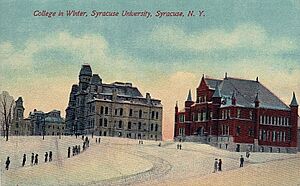
Two important people helped Syracuse University grow a lot: Chancellor James Roscoe Day and John Dustin Archbold. Archbold was a successful businessman and gave almost $6 million to the university. He helped pay for many buildings, including Archbold Stadium (opened 1907), Sims Hall (1907), and the Archbold Gymnasium (1909).
In 1905, Andrew Carnegie donated $150,000 for a new library. The university raised more money to match his gift. The new Carnegie library opened in 1907 with over 71,000 books.
Modern University Life
After World War II, Syracuse University became a major research school. Many veterans came to study because of the G.I. Bill. This bill helped pay for their education. In 1946, almost four times more freshmen enrolled than before the war. Syracuse also opened branch campuses that later became Binghamton University and Utica University.
By the late 1950s, Syracuse was one of the top universities for research. It had hundreds of professors and students working on new discoveries. The university added new programs like computer engineering and bioengineering. In 1962, Samuel Irving Newhouse Sr. gave $15 million to build a communications school, now called the S.I. Newhouse School of Public Communications. In 1966, Syracuse University joined the Association of American Universities, a group of leading research universities.
Remembering Flight 103
On December 21, 1988, 35 Syracuse University students died in a plane bombing over Lockerbie, Scotland. The students were coming back from a study trip in Europe. This event was a very sad time for the university.
Every year, Syracuse University holds "Remembrance Week" to honor these students. The university also has a "Remembrance Scholars" program. In this program, 35 senior students receive scholarships. There is also a "Lockerbie Scholars" program, where two students from Lockerbie, Scotland, can study at Syracuse for a year.
Recent Campus Changes
In July 2025, Chancellor Kent Syverud announced that the university had changed its Office of Diversity and Inclusion. It was replaced with an "Office of People and Culture" within Human Resources. This change followed new federal policies.
University Campuses
Syracuse University's campus has a mix of old and new buildings. The center of campus has a grassy quad, walkways, and outdoor art. It feels like a classic college campus. The university is located above downtown Syracuse, a city with about 150,000 people.
The university also owns a Sheraton Hotel on campus (now Orange Hall). It owns the Marshall Square Mall and the Drumlins Country Club, a golf course. Syracuse University also has locations in New York City and Washington, D.C.. It also has a retreat center in the Adirondack mountains.
Main Campus Area
The Main Campus, also called "North Campus," has almost all the academic buildings and student dorms. The main part is The Kenneth A. Shaw Quadrangle, or "The Quad." Academic buildings and Hendricks Chapel surround it. Buses run from here to South Campus and downtown Syracuse.
About 70% of students live in university housing. First and second-year students must live on campus. All 22 dorms are coeducational, meaning both male and female students live there. Each dorm has a lounge, laundry, and study areas. The dorms are secure with card access.
The Comstock Tract Buildings, a group of older buildings on campus, are listed as a historic district. Three buildings—Crouse Memorial College, the Hall of Languages, and the Pi Chapter House of Psi Upsilon Fraternity—are also individually listed as historic places.
South Campus Area
After World War II, a large hill owned by the university was used for housing veterans. In the 1970s, these temporary homes were replaced with permanent townhouses. These homes have kitchens, bathrooms, and private bedrooms. More than 2,000 students live on South Campus. It is about a mile from Main Campus, and shuttle buses run often.
South Campus has the Institute for Sensory Research, Tennity Ice Skating Pavilion, and the Goldstein Student Center. It also has the Inn Complete pub, a graduate student bar.
Nearby is the John A. Lally Athletics Complex, where 20 Syracuse University sports teams practice. This area also has the Carmelo K. Anthony Basketball Center and the SU Soccer Stadium.
Downtown Syracuse Locations
In 2004, the university bought or leased buildings in downtown Syracuse. Five design programs are now located in a renovated building called The Warehouse. These programs work closely with the community. The Warehouse also has a modern art space. The School of Architecture also moved downtown temporarily for renovations to its building.
The Syracuse Center of Excellence works on new ideas in environmental and energy technology. The Paul Robeson Performing Arts Company and the Community Folk Art Center are also located downtown.
The Connective Corridor project aims to link the main campus to the arts and culture areas downtown. This project is supported by public and private money.
Other Locations
Syracuse University has offices in Los Angeles, New York City, Atlanta, Chicago, and Boston. These offices help the university connect with alumni and future students. The Maxwell School of Citizenship and Public Affairs also has operations in Washington, D.C.
Art and Collections
Art Collections at SU
Syracuse University has its own art museum, the Syracuse University Art Museum. Its main gallery is in the Shaffer Art Building.
The Warehouse Gallery is a new art space that is part of the SU Art Museum. It shows art from artists around the world.
The Louise and Bernard Palitz Gallery is in New York City. It has changing art shows, including works from the university's own collection.
Other Art Spaces
There are many other places for students to show their art at Syracuse University. These include the Lowe Art Gallery, the Robert B Menschel Photography Gallery, and the White Cube Gallery.
SU has a large art collection with over 45,000 objects. It includes works by famous artists like Picasso and Rembrandt. More than 100 important artworks are displayed around campus.
Students can also explore old documents and special collections at the Special Collections Research Center (SCRC). This center has rare books, old writings, and items related to architecture, design, and popular culture.
Academics and Learning
| School founding | |
|---|---|
| School | Year founded |
|
|
|
| College of Arts and Sciences | 1871 |
| College of Visual and Performing Arts | 1873 |
| School of Architecture | 1873 |
| College of Law | 1895 |
| School of Information Studies | 1896 |
| College of Engineering and Computer Science | 1901 |
| School of Education | 1906 |
| Graduate School | 1912 |
| Falk College of Sport and Human Dynamics | 1917 |
| College of Professional Studies | 1918 |
| Whitman School of Management | 1919 |
| Maxwell School of Citizenship and Public Affairs | 1924 |
| Newhouse School of Public Communications | 1934 |
Syracuse is a large research university where most students live on campus. It offers many different programs. The university is approved by the Middle States Commission on Higher Education.
The most popular majors at Syracuse University include: Communication, Journalism, Business, Visual and Performing Arts, and Engineering. Most freshmen (91%) stay at Syracuse after their first year. There are 15 students for every teacher, and over half of the classes have fewer than 20 students.
How the University is Organized
Syracuse University is run by a board of trustees. This board chooses the chancellor and sets their salary. The university also has a senate that helps make decisions about education. The senate includes administrators, teachers, students, and staff.
Syracuse University has 13 different schools and colleges.
Becoming a Syracuse Student
| Admissions statistics | |
|---|---|
|
2023 entering
classChange vs. 2018 |
|
| Admit rate | 41.7%
(
|
| Yield rate | 20.9%
(
|
| Test scores middle 50%* | |
| SAT Total | 1280–1410 (among 24% of FTFs) |
| ACT Composite | 28–32 (among 9% of FTFs) |
| High school GPA | |
| Average | 3.8 |
|
|
Getting into Syracuse is "more selective." For the 2023 class, Syracuse accepted about 42% of students who applied. About 21% of those accepted decided to enroll. In 2024, the school received around 45,000 applications.
In 2018, many students came from diverse backgrounds. Students came from 48 states and 59 different countries.
Degrees and Programs
The university offers over 200 different majors for undergraduate students. You can earn a Bachelor's degree from nine different schools and colleges. Syracuse also offers Master's and doctoral degrees.
Syracuse has had international study programs since 1911. SU Abroad offers programs with universities in over 40 countries. The university has eight international centers in places like Beijing, Florence, London, and Madrid.
University Rankings
U.S. News & World Report ranked Syracuse tied for 58th among national universities in 2021. In 2019, Syracuse University was ranked 22nd in New York State for average professor salaries. Syracuse was also named one of the top schools for Fulbright Awards in 2020–21.
The School of Architecture's Bachelor of Architecture program was ranked 5th nationally in 2019–20.
The School of Information Studies offers courses in information management and technology. Its graduate program was ranked 6th best in the U.S. for Library and Information Studies in 2022.
The Martin J. Whitman School of Management was named after a Syracuse alumnus in 2003. Its graduate business program was ranked 84th in 2022.
The College of Law was ranked 102nd nationally in 2022. It is known for its work in National Security Law. Former President Joe Biden graduated from the College of Law.
The Maxwell School of Citizenship and Public Affairs combines social sciences with public administration. It was ranked as the No. 1 graduate school for public affairs in the U.S. in 2022.
Military Times ranked Syracuse University the top "Private School for Vets" in 2020. Syracuse University was also ranked tied for 30th in "Best Colleges for Veterans" by U.S. News & World Report for 2022. The university opened the National Veterans Resource Center (NVRC) in 2020. This center helps veterans and military families.
The graduate program of the College of Visual and Performing Art (VPA) is considered one of the top 50 programs in the US. VPA ranked highly in multimedia/visual communications, ceramics, printmaking, and sculpture.
University Libraries
Syracuse University's main library is the E. S. Bird Library, which opened in 1972. It has over 2.3 million books and many other materials. The historic Carnegie library holds the Science and Technology collection.
The university's Special Collections Research Center has many important historical items. These include ancient tablets, old manuscripts, and early printed books. It also has the personal library of Leopold Von Ranke, a famous historian.
Bird Library also has the largest collection of national archives from Kenya and Tanzania. It is also home to the Belfer Audio Laboratory and Archive. This archive has about 540,000 recordings, including voices of famous people like Thomas Edison and Albert Einstein.
University Faculty
Syracuse University has over 1,000 full-time teachers. Most of them have advanced degrees. The faculty includes many well-known scholars and experts in their fields.
University Research
Syracuse is known as a university with "Very High Research Activity." In 2019, Syracuse spent $154.3 million on research and development. The university supports research in many areas, including business, science, engineering, education, and communications. Syracuse was a member of the Association of American Universities (AAU), a group of top research universities.
SU has 29 research centers and institutes. These centers often work across different subjects. For example, the Burton Blatt Institute researches issues for people with disabilities. The Martin J. Whitman School of Management has many research centers for business topics.
Syracuse University also works with large science projects like CERN and Fermilab. It also has many researchers working on the LIGO Scientific Collaboration, which helped discover gravitational waves in 2015.
In June 2022, Syracuse University started the Center for Democracy, Journalism and Citizenship in Washington D.C. This center works to improve trust in journalism and democracy.
Syracuse University Press
Syracuse University Press is the university's publishing house. It publishes books on topics like Middle East studies, Native American studies, and New York State history. The press started on August 2, 1943.
Student Life at SU
| Race and ethnicity | Total | ||
|---|---|---|---|
| White | 55% |
|
|
| Foreign national | 14% |
|
|
| Hispanic | 10% |
|
|
| Black | 7% |
|
|
| Other | 7% |
|
|
| Asian | 7% |
|
|
| Native American | 1% |
|
|
| Economic diversity | |||
| Low-income | 14% |
|
|
| Affluent | 86% |
|
|
Syracuse University has students from all 50 U.S. states and over 127 countries. About 15% of students are from outside the U.S. The Center for International Services helps these students.
Student Media
CitrusTV is the university's student-run television studio. It is one of the largest in the country.
Students also run many magazines and newspapers. The Daily Orange is an independent student newspaper published daily during the school year. It is often ranked among the best student newspapers in the U.S.
WAER is a radio station owned by the university. It plays jazz music and NPR programs. WJPZ-FM and WERW are student-run radio stations.
Student Government
The Student Association (SA) represents undergraduate students. They elect a President and Vice President each year. The SA helps students have a voice in university decisions.
Graduate students are represented by the Graduate Student Organization (GSO). Law students are represented by the Law Student Senate. These groups elect students to the Syracuse University Senate.
Fraternities and Sororities
Syracuse University has many fraternities and sororities. These groups are part of different national councils. Students from the College of Environmental Science and Forestry can also join these groups.
The oldest fraternity at SU is Delta Kappa Epsilon, started in 1871. The first sorority, Alpha Phi, was founded in 1872. Gamma Phi Beta was the first group to use the term "sorority" in 1874. The university does not allow these groups to treat people unfairly based on race, gender, or other factors.
Syracuse University Ambulance
Syracuse University Ambulance (SUA) is a student organization that helps with medical emergencies. It was started in 1973 by students who saw a need for emergency services on campus. SUA has about 100 student volunteers. They provide emergency and non-emergency services 24 hours a day during the school year.
Campus Events and Traditions
University Union (UU) is the official group that plans events for the university. It is run by students. UU hosts big concerts like Juice Jam and Block Party. They also show movies and bring comedians and speakers to campus.
The Goon Squad is a group of student volunteers who welcome new students and their families. This group started in 1944 and is a long-standing tradition at Syracuse.
Religious Life
Hendricks Chapel is an interfaith chapel on the Quad. It is the spiritual center of Syracuse University. The Chapel has ten different chaplaincies for various faiths, including Christian, Buddhist, Islamic, and Jewish.
There are also many student religious groups. Other buildings on campus support specific religious groups, like the Alibrandi Catholic Center and the Winnick Hillel Center for Jewish Life.
Campus Food
The university has five dining halls, thirteen cafes, and two food courts. The Ernie Davis dining hall, built in 2009, is known for its design and is considered one of the best dining halls in the U.S. Syracuse manages its own food program. Since 2017, the university has been recognized for its vegan food options.
A student group called the Food Recovery Network donates leftover food to food banks. In fall 2021, they donated over 5,000 pounds of food. The dining halls also collect food waste to turn into compost. Two student-run food pantries on campus help students who need food.
University Athletics
Syracuse Orange Teams
Syracuse University's sports teams are called "the Orange." The school's mascot is Otto the Orange. SU has teams in eight men's sports and 12 women's sports. The men's and women's basketball teams, the football team, and both lacrosse teams play in the JMA Dome. Other sports are played at Manley Field House or the Tennity Ice Skating Pavilion. Most Syracuse teams play in NCAA Division I in the Atlantic Coast Conference.
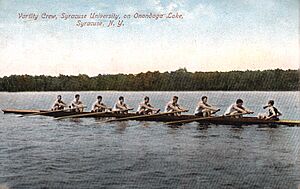
SU teams have won 31 national championships. These include 14 for men's lacrosse and six for men's rowing. The men's basketball team, led by Hall of Fame coach Jim Boeheim, won the 2003 NCAA championship. The men's basketball team holds the record for the largest attendance at an on-campus game, with 35,642 fans watching them play Duke in 2019.
In 1959, Syracuse won its first National Championship in football. The team had Ernie Davis, who in 1961 became the first African-American to win the Heisman Trophy. Sadly, Davis passed away before he could play professionally.
Syracuse lacrosse teams have won many championships. The men's team has won 11 National Championships, more than any other college lacrosse team. The women's lacrosse team reached the NCAA Division I National Championship game in 2012.
Syracuse University's rowing teams are also very successful. They are full members of the Intercollegiate Rowing Association (IRA).
The JMA Dome
In the late 1970s, Syracuse University needed to improve its football stadium. The old stadium, Archbold Stadium, was too small and old. So, the university decided to build a new stadium. In 1978, Archbold Stadium was taken down to build the Carrier Dome. It was named after Carrier Global Corporation, which gave a large gift. The Dome has a special roof and is also home to the men's basketball team. It was built between 1979 and 1980.
In 2018, the university announced a big renovation for the Carrier Dome. This $120 million project was finished in 2022. The old roof was replaced with a new, fixed roof, and air conditioning was added. The Dome also got a huge video board, new lights, and better sound systems.
In May 2022, Syracuse University and JMA Wireless made a deal to rename the Carrier Dome to the JMA Wireless Dome, or JMA Dome. This was only the second name for the stadium since it opened in 1980.
Famous Alumni
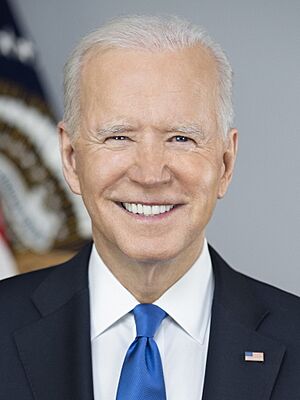
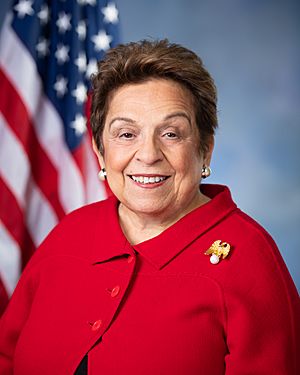
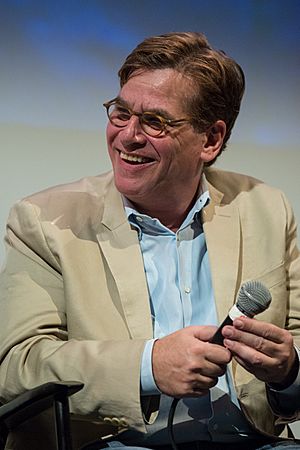
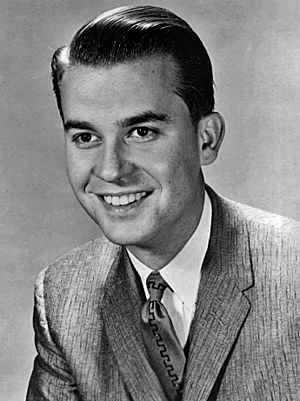
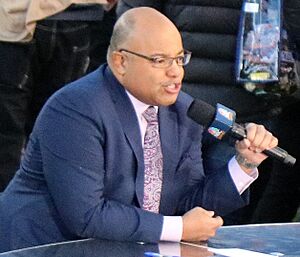


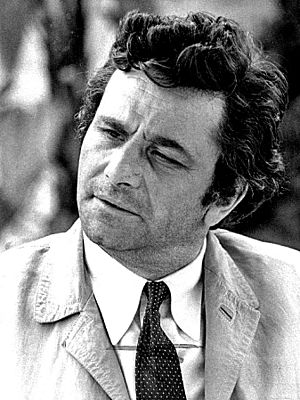

Syracuse University has over 260,000 alumni (former students). They live in all 50 states and over 171 countries. Many famous people have attended Syracuse University.
Some well-known alumni include:
- Writers like George Saunders and Joyce Carol Oates.
- Politicians like Joe Biden, the 46th President of the United States, and Kathy Hochul, the 57th Governor of New York.
- Scientists and inventors like Robert Jarvik, who invented the first artificial heart, and Eileen Collins, the first female Space Shuttle commander.
- Business leaders like Arthur Rock, who helped start Intel.
- Journalists and broadcasters like Ted Koppel, Megyn Kelly, Bob Costas, and Mike Tirico.
- Actors and performers like Dick Clark, Taye Diggs, Peter Falk, Vera Farmiga, and Vanessa Williams.
- Athletes like Kathrine Switzer, the first woman to officially run the Boston Marathon, NFL Hall of Famer Jim Brown, Ernie Davis, and NBA star Carmelo Anthony.
University Connections
Partner Institutions
State University of New York College of Environmental Science and Forestry
The College of Environmental Science and Forestry (ESF) has a long connection with Syracuse University. ESF's main campus is right next to Syracuse University, and they share many resources. ESF was founded in 1911 as the New York State College of Forestry at Syracuse University.
ESF is its own school, but it works closely with SU. Students at both schools can take classes at the other. Degrees from ESF even have the Syracuse University seal. The two schools have joint ceremonies for new students and graduation. Students from both schools can use the libraries, sports facilities, and clubs at both universities.
State University of New York Upstate Medical University
The medical school was once a part of Syracuse University. In 1950, SU sold the medical school to the State University of New York system. The campuses of the two universities are next to each other. They work together on some programs, like a Master of Public Health degree.
Former Partner Institutions
State University of New York at Binghamton
Binghamton University started in 1946 as Triple Cities College. It was a branch of Syracuse University. In 1950, it became part of the State University of New York system.
Utica University
Utica University was founded by Syracuse University in 1946. It became an independent university in 1995. However, Utica University still allows its students to get a special bachelor's degree from Syracuse University through their partnership.
See also
 In Spanish: Universidad de Siracusa para niños
In Spanish: Universidad de Siracusa para niños
- Syracuse University Alma Mater


